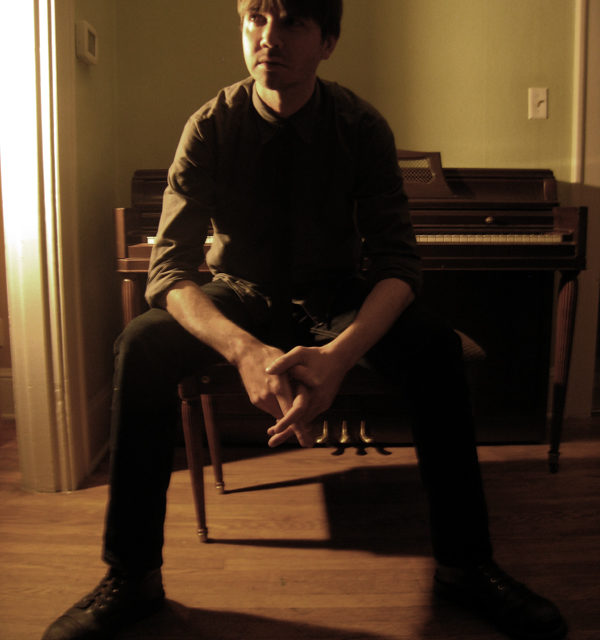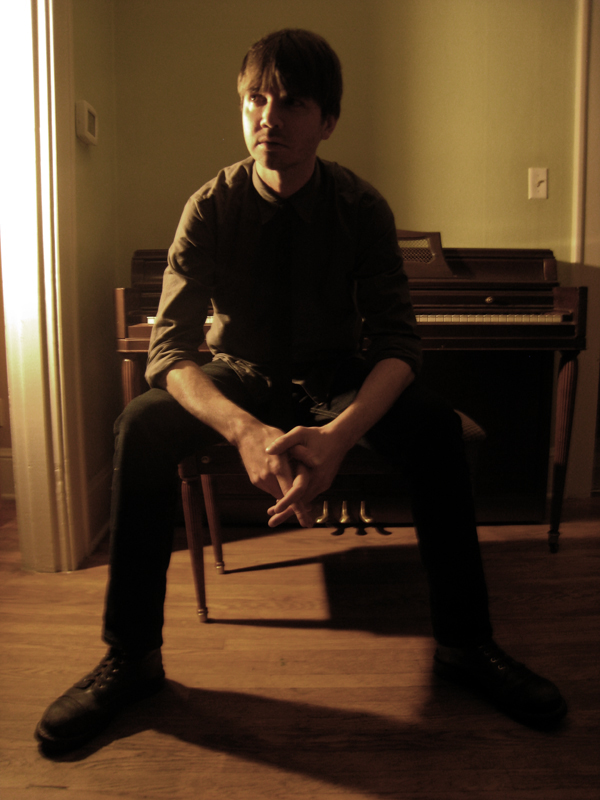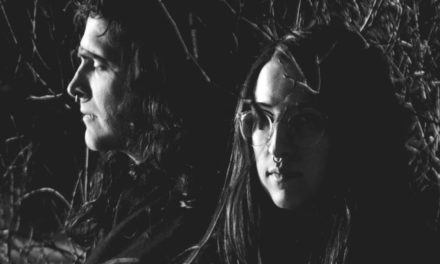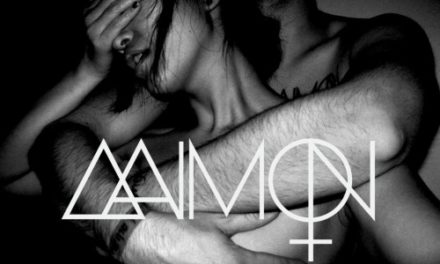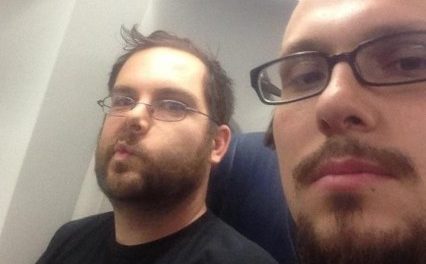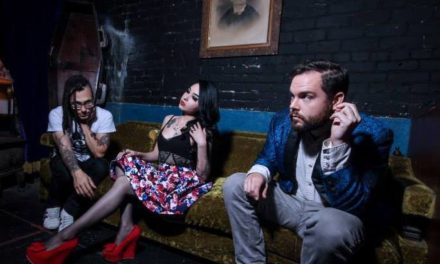“I want it to be dark and sound like industrial music, but there always has to be melody, there always has to be that classically musical feeling.”
Michael Holloway’s Dead When I Found Her project has been getting pretty consistent play from us ever since we opened the doors at ID:UD HQ. From the classic Puppy-steez of their debut Harm’s Way to the poppier excursions of Rag Doll Blues to a non-stop stream of covers and other one-off tracks, DWIFH has steadily emerged as one of the key names in modern electro-industrial. Being interested in how his vision for the band initially developed, and how it and his workflow had progressed in the past couple of years, we provided Michael with a list of tracks which we felt represented a wide swath of DWIFH’s range, and asked him for his comments and reflections on them, to act as a sort of oral history of the project in Michael’s own words.
“Fortune’s Few” (from Harm’s Way, 2010)
I almost felt like the rest of the song was just an excuse to have that particular drum loop. It’s a pretty classic-style syncopated rhythm. I could probably name some Puppy songs with a similar pattern, but once i had it down, it was so punchy and catchy, I basically just built a song around it.
It was a very early song, probably among the first five songs for the project. Definitely it was part of me “finding” the sound of [Dead When I Found Her]. At the time I had no contract with Artoffact, no broader sense of what would happen with DWIFH. It was there with “Glass Trap” (unreleased), and “Phantoms” and “Fixer Fixed”, the first batch of songs I finished. I think it helped me solidify what I was doing, stylistically, it was short and direct, which is always a challenge for me. “Fortune’s Few” and “Phantoms” please me simply because I kept them under four minutes! I always write these giant songs and then have to go in and cut out the redundant parts. “Fortune’s Few” was pretty short and tight from the beginning.
“Fortune’s Few” and a few others were songs I made on a PC laptop right after buying Ableton Live 7. The program was brand new to me and I had been away from music making for quite a while, mostly due to the fact that I’d been living in South America. I basically got home, and decided that I needed to start a music project and take it seriously, more seriously than I’d taken other projects before. It was a way to sort of define the next phase of my life, having just returned to Portland after a long period of travel. So I bought Ableton, just on a recommendation, because I knew I wanted something new to play with, and bought a bunch of plugins. The concept of a plugin was actually new to me at that time, if you can believe it. This was all 2008. In the past I always recorded stuff direct into Cooledit Pro for audio sequencing, or recorded parts I’d sequenced in an old K2000, or sequenced MIDI in Reason, and exported that into Cooledit. So, crazy as it sounds, even in 2008 I was new to actually using a DAW where I had access to plugins as well as recording audio-in, so I had a shit ton to learn!
“Fortune’s Few” is the one song where I’ve gone back and prepared a version for the live shows, meaning, beyond the ones we already do from Harm’s Way, that’s the only additional one I’ve added. The live version alters the chorus slightly to keep the drums punchier and up front, and drops part of the synth arpeggio midway through the song, but overall it will feel/sound the same.
“Lost House” (from Harm’s Way, 2010)
“Lost House” is a favorite of mine, easily. I think it’s one of the songs that most captured why I started the project in the first place. Right off the bat when the drums and synthline kick in, I knew I was doing what I wanted to be doing, It has that “feel” of something old and yet something new. So that song was, more than some others, one where I really felt like “Okay, I can do this, I’m accomplishing exactly what I set out to do.” It has “that sound”, which is what I usually use to refer to late 80’s early 90’s electro-industrial.
Harm’s Way was interesting because, as I mentioned, I was basically learning all the tools while I used them to make the songs, everything felt new. “Lost House” worked for me because it was musical, that is to say melodic and pretty, but also felt dark, with heavy drums, and industrial elements. That’s pretty much the whole approach to DWIFH; I want it to be dark and sound like industrial music, but there always has to be melody, there always has to be that classically musical feeling. The drums, the delayed synth line at the start and the dark bassline that follows the drums closely, all of that, to me anyway, “feels” like what I want industrial music to feel like.
Also, there’s syncopation in the rhythm programming. This came up a while ago on the VP forum, somebody correctly noted that one major shift in the genre is a shift away from notably syncopated rhythms to a more generic steady dance beat. It’s something I think about a lot both as a listener and as a musician.
“Fixer Fixed” (from Harm’s Way, 2010)
“Fixer Fixed” is the second DWIFH song I finished, there were many unfinished sketches from that time. The first was “Glass Trap”, which also has a lot of guitars. Right before I started DWIFH I was listening to a ton of black metal and death metal, and playing a lot of metal guitar. I’d bought Guitar Rig, which blew my mind, in that I didn’t need to use my amp any more, I could just record direct into my computer. So all the early stuff was very guitar-driven simply because I’d been in a metal phase. A phase, mind you! I’m always a bit on-and-off with metal.
Here’s an anecdote nobody knows: before I started Dead When I Found Her, I recorded two songs: total black metal and death metal songs. Literally speaking, those two songs were the first “Dead When I Found Her” songs, because i’d already come up with the name and when I wrote those songs, that’s what I called the project. Metal is just an on/off phase for me, whereas industrial, I’ve been listening to constantly since I was 14. So it was inevitable, really, that with my new music software and new ambitions to make music, metal wasn’t going to win, turning toward industrial was inevitable. Nonetheless, the literal beginning was two metal songs.
“No More Nightmares” (from Rag Doll Blues, 2012)
It became clear to me pretty quickly when writing that one that it would be the lead-off track; it contained both the old, and the new. Musically, the song is in triplets as is “New Age of Reason”, but they are obviously very different. Writing music is very instinctual for me, it’s hard to describe the how and why of choices I made in a given song, because I just do it by instinct during the compositional process. “No More Nightmares” feels like this very designed, specifically conceived piece when I listen to it now, but at the time, those choices, to have the piano, the horns, the shift between classical sounding music and industrial sounds – it was just something that happened organically.
I was writing lyrics about childhood and memory of childhood, how cloudy and vague it feels, so I went searching online for public domain samples of kids and found all this great stuff, random voices and dialogue. I just chose the ones that worked best atmospherically and fit with the concepts I was already working on lyrically and then specifically put those at the start of “No More Nightmares” so those ideas would get introduced right off the bat.
It’s one of the very last [songs written], right toward the end, really, which is funny in a sense, as it leads off the album. It basically was a culmination of other motifs and ideas I’d been working with. I’d already put the horns into “Doll Parts” and “Doll Pieces” for example, so I thought, “Hey, I can bring those in here, too”. The horns were literally the result of me having a big Horse Rotorvator phase. I wrote “Doll Pieces” after listening to it and thinking, damn, Coil really knew how to put brass into industrial music. Gear-wise, I use NI Kontakt 5 for all the sampled instruments. I love that program to death, it might be my favorite instrument of everything I have.
“Rain Machine” (from Rag Doll Blues, 2012)
If anything was designed as a “single” on that album, it was “Rain Machine”, though of course, the tempo is like, 100 or something. Not exactly single territory BPM, hah. I always feel so much more comfortable working in the 90 – 116 range. When it comes to songwriting, there are very few DWIFH songs over 120. Anyways, on “Rain Machine” the chorus was meant to be a hook, so I did have “pop song” in mind, in that sense.
When I’m working on these albums, I’m definitely aware of how many songs I have that fit certain categories, so when I did [“Rain Machine”] I wanted something that was more accessible, and without the longer, repeating passages of songs like “Dry Bed” or “Mirrors”. I think about how songs fit together as an album, and I want some that are long, some that are shorter, some that feel lighter and poppier, and some that feel longer and darker and so on. People have asked me why I cut “Worlds Apart”, and it’s simple: it was way too long and I didn’t want to cut the long songs I already had on there. There are certainly already a lot of long songs on the album!
“Mirrors” (from Rag Doll Blues, 2012)
That song, of everything on the album, was written and completed faster than anything else. The inspiration was Tired Eyes Slowly Burning by The Tear Garden, if you follow the drum pattern in the first half of the song, it’s very similar to the style of drumming on the first four songs on Tired Eyes. I wanted that kind of movement and feel to the drums the start/stop punctuation. Musically the song came together very quickly, it was a great night of songwriting, I basically completed nearly the whole thing in one session. As far as influences go: Coil, Tear Garden, Hounds of Love by Kate Bush. I wanted a very musical sounding album of otherwise dark industrial music. So those influences kind of make sense, because they’re more pop, more musically structured projects. Okay, not Coil. *laughter*
Psyche, “The Crawler (Dead When I Found Her remix)” (from Re-Membering Dwayne, 2010)
Jeremy at Artoffact/Storming the Base basically said, “Hey, I bet you’d like this opportunity; wanna remix something Dwayne Goettel worked on? So of course I said yes.” To be honest, I’d never heard of Psyche, they were totally new to me. But the craziest part was that he didn’t have any stems for that track: nothing. I had to take the original, very lo-fi mix and just chop it up. Somehow I managed to isolate some of the vocals, there is still music playing with parts of them, but my music was louder so you can’t really tell. That “remix” is basically 98% a composition I wrote around some weirdly hacked/chopped bits of the original full mix. There was no other way to approach it. I started with the isolated vocal loop and just built on top of it. It was the first remix I’d done, pretty much, but honestly, in the Psyche case, it was a lot like the process of writing my own stuff. With other remixes I’ve been able to do more literal “remix” work.
Ayria, “Blue Alice (Dead When I Found Her remix)”, (from Various Artists, Electronic Body Matrix 1, 2011)
Ayria – Blue Alice (DEAD WHEN I FOUND HER) by h4x0r666
The Ayria mix Jeremy made me re-do like three or four times, just saying “the vocals aren’t loud enough!” He has this thing about vocals being too low in a mix, I kept sending it back, saying “It’s good now!” and he’d say “No it’s not! make them louder damn it!” *laughter* By the time it was done I never wanted to hear Jennifer Parkin’s voice again. I kid, I got over it.
Kill to Cure (Skinny Puppy cover, from Rag Doll Blues, 2012)
I found a Youtube video, pretty shitty quality, but good enough that you can sort of hear what the main drum pattern is doing, and more or less what the bassline is. Obviously I had to take some liberties with it, but since the song is mostly constructed from the drums, the synth bass, and Ogre, it actually wasn’t that hard. There aren’t any complex musical parts, it’s all rhythm, with a drone in the background, at least in that version. Since then, I’ve heard other ones and they can sound pretty different, they’re all live shows, of course. Ogre changed the lyrics a lot, so my version is this sort of hybrid. “Here’s what i THINK he’s saying in this video – but I can’t really tell.” I had to take liberties. As a huge Puppy fan, I deliberately set out to make my ‘cover’ sound like what I thought “Kill to Cure” would sound like, if SP had made a studio version of it.
“Controversy” (Prince cover, released via Soundcloud, 2012)
I’m a huge pop music fan. I like 80s music, I like funk and even some disco, so needless to say I LOVE old Prince. “Controversy” is just a classic. The hook is so catchy and I thought, I bet I could do an “electro” version of this, and keep the catchiness of the chorus, but make it feel bigger, so that’s what I set out to do.
It really was disconnected from Rag Doll Blues. the album was done and in the hands of the label by the time I did it. Almost all of my covers were started on my MacBookPro while I was bored at work. I have a different job now, but at my old job, I’d work swing shift in a house for crazy people, to put it crassly. After 8pm, they’d be medicated and go to bed so I’d have all this time to basically do nothing.
Generally I don’t like using the laptop for music work anymore, I have a much nicer setup with an iMac at home, but at least at work I could figure out the notation to the song I was covering and create all the midi parts in Ableton, then take those home, send them over to my main rig, and do the full song. The song already being written takes a certain edge off creatively: you can focus on stylistic things and not worry about coming up with the chords or the hook. I mostly see [covers] as a way to be making music when I need a break from original creative composition. For me, it’s fun, and for the project, it’s a way to keep the band alive in between albums, remind people it still exists.
Rag Doll Blues is available on CD and via all major online music retailers.

